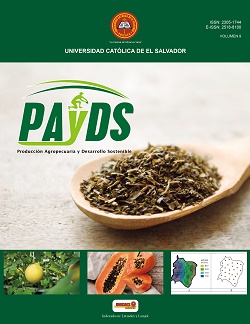Determinación de la concentración mínima y máxima del extracto de orégano (Origanum vulgare) como sustituto natural para preservar productos cárnicos
DOI:
https://doi.org/10.5377/payds.v9i0.11855Palabras clave:
Sales de nitrito, Salmonella, Listeria monocytogenes, E. coli, coliformesResumen
En productos cárnicos crudos y cocidos suelen emplearse diferentes elementos para resaltar las características sensoriales (sabor, color), y alargar su vida útil. La investigación comprendió la formulación y elaboración de chorizo mexicano y jamón tipo Virginia, utilizando diferentes dosis de aceite esencial de orégano; para comparar su efecto conservador frente a las sales de cura de nitrito de sodio. También se incluyó un control negativo por medio de pruebas microbiológicas en productos cárnicos elaborados. Se realizaron diez repeticiones de formulación para ambos productos en diferentes días. De cada producción se tomaron muestras al azar para los análisis sensoriales y microbiológicos, encontrándose diferencias estadísticamente significativas, según prueba de Tukey (p<0.05); específicamente en las pruebas sensoriales para la muestra de jamón Virginia, con sales de cura de nitrito de sodio para los parámetros de color; y en la muestra de chorizo mexicano, con dosis de 50 ppm de aceite esencial de orégano, respecto a parámetros de olor y preferencia. Las pruebas microbiológicas para determinación de ausencia/presencia de Salmonella, y Listeria monocytogenes, E. coli, y coliformes, no mostraron diferencias estadísticamente significativas, según prueba de Tukey (p<0.05), para las muestras de jamón Virginia y para chorizo mexicano.
Descargas
615
Descargas
Publicado
Cómo citar
Número
Sección
Licencia
© Producción Agropecuaria y Desarrollo Sostenible
El copyright de los artículos se transfiere a la revista Producción Agropecuaria y Desarrollo Sostenible.
Como usuario de esta revista, usted posee:
● Acceso abierto para consultar la información contenida en este número
● Permiso para copiar, distribuir, mostrar, realizar o combinar las prácticas anteriores, en cuanto al uso de la información, siempre y cuando esta sea estrictamente sin fines de lucro.
Este revista utiliza una licencia CC BY-NC

Este obra está bajo una licencia de Creative Commons Reconocimiento-NoComercial 4.0 Internacional




